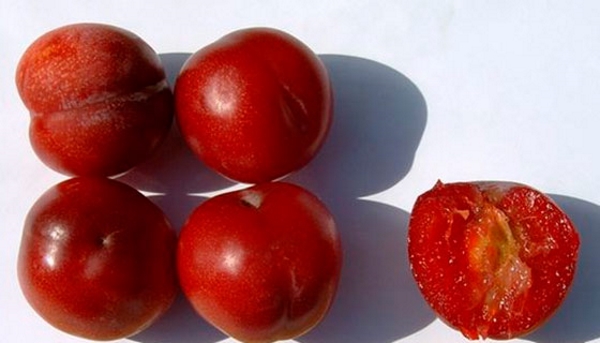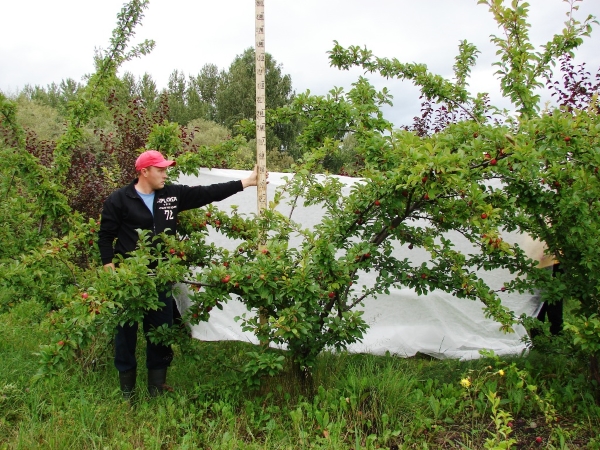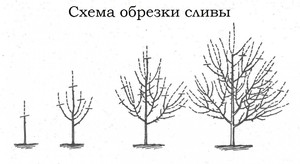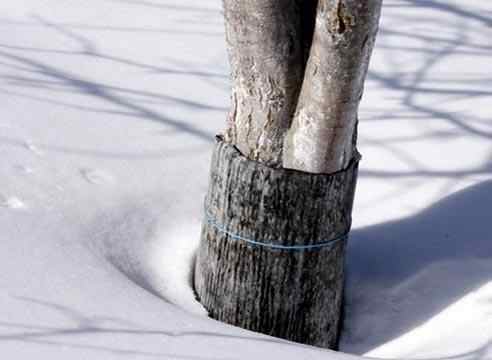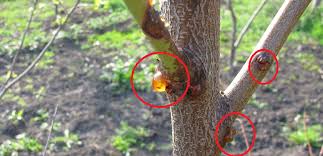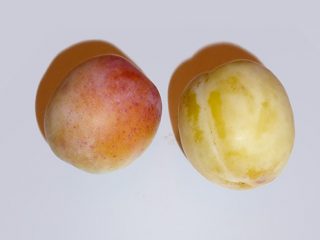Content
Plum Krasnomyasaya is one of the most favorite varieties of plum among gardeners. It grows both in the southern regions and northern ones: in the Urals, in Siberia. High adaptability and survival rate in almost any conditions made this variety the most common in any region of the country.
Breeding history of the variety
The plum variety Krasnomyasaya was obtained at the Lisavenko Scientific Research Institute of Plant Industry in Altai (Chemal) by crossing the Chinese plum and cherry-plum. Plum Krasnomyasaya has many subspecies, such as Oval, Bolshaya, Podgornaya and others. All 12 types of this plum are frost-resistant and high-yielding.
Description of plum Krasnomyasaya
- The tree is not very tall, reaches 4 m, but in garden farms they grow representatives of this species with a height of 3–3.5 meters.
- The bark is smooth, light gray. Plum Krasnomyasaya has a compact crown, thin, spherical. It is good to place low-growing plants in the openwork shade of a tree.
- The leaves of Krasnomyasa are dark green, jagged. The leaf blade is fleshy, light green underneath. The surface is smooth, glossy.
- The flowers are small, pale pink in color, with regular oval petals, their usual number is 5.
- The fruits are dark red, fleshy, juicy, have a sweet and sour taste with a pronounced plum aroma. The shape of the berries is round, sometimes a little elongated. The skin is sour, it can be bitter. The stone is small, oval, easily separated from the pulp. Fruit weight ranges from 20 g to 30 g.
- The Krasnomyasaya plum has an average ripening period. Harvesting takes place in mid-August. Up to 20 kg of berries can be harvested from one tree. They tolerate transportation well, do not deteriorate.
The variety is grown everywhere in the southern and northern regions, since Krasnomyasaya plum is frost-resistant and drought-resistant.
Variety characteristics
Plum Krasnomyasaya possesses all the main features of its congeners, but there are still some features of the variety.
Drought resistance, frost resistance
Plum Krasnomyasaya is a drought-resistant variety that does not tolerate the proximity of groundwater, the effects of wind and drafts.
Differs in high frost resistance. It tolerates winters well. This is due to its spread in the northern regions.
Pollinators of plum Krasnomyasaya
The Krasnomyasaya variety is self-fertile, therefore it requires the planting of pollinators in the neighborhood. Often they choose the Ussuri plum for this, hybrid cherry plum is also suitable. It is well pollinated with Skoroplodnaya and Russian plums. The flowering period of these species falls on the beginning of May, the presented varieties bloom synchronously, so there are no problems with pollination. Fruit ripening occurs in the second half of August.
Productivity and fruiting
Fruiting of the Krasnomyasaya plum variety occurs in mid - late August, depending on the region. In the southern part of Russia, plums begin to ripen in early August, in the northern regions - in the last days of summer.
Plum Krasnomyasaya has a high yield. Up to 20 kg of fruit can be harvested from one tree.The variety bears fruit annually, regardless of weather conditions.
Scope of berries
The fruits of the Krasnomyasaya plum are used both fresh and processed. Dried fruits, juice, jam, baked goods are prepared from them. Housewives make preparations for the winter from plum fruits.
Disease and pest resistance
Plum Krasnomyasaya is a variety that is resistant to most pests and diseases typical of plums. Not affected by aphids, but prone to gum flow. It resists well the main enemy of plums - klyasterosporium.
Advantages and disadvantages of the variety
Benefits of Krasnomyasoy:
- high productivity;
- good fruit taste;
- frost resistance and drought resistance;
- resistance to most diseases inherent in plums;
- high adaptability to climatic conditions;
- annual fruiting.
Disadvantages of plum:
- self-fertility (requires pollinators);
- likes good lighting;
- does not tolerate drafts;
- needs non-acidified soils, where there is no groundwater.
This variety has more advantages than disadvantages. This is the reason for the wide distribution of plums in Europe and Asia.
Landing features
Krasnomyasaya does not differ in most planting conditions from its congeners. But the plum is demanding on the place of planting and the choice of neighbors.
Recommended timing
The tree is planted in the spring, after frost, in the soil already warmed up by the sun. Depending on the region, this can be the end of March - the beginning of May.
Planting is possible in the fall, before the onset of frost, when the soil is still warming up enough, and night temperatures do not drop below zero.
Choosing the right place
Red meat grows on any soil, except for acidified ones. Requires a well-lit area.
It is advisable to place the seedling in the south or in the eastern part of the site. The place for the plant is chosen on a sunny one, excluding the windy side. It is good to plant a tree under the cover of a building, fence, and other trees.
Plum planting:
What crops can and cannot be planted nearby
Plum Krasnomyasaya gets along with many horticultural crops. The only thing that cannot be planted nearby is tall trees. Red meat cannot stand blackout.
Since this variety is self-fertile, it is good to plant a seedling surrounded by cherry plum and any of the types of Russian plum, keeping a distance of 10 meters.
Selection and preparation of planting material
It is better to buy a seedling for planting in a nursery in order to get a beautiful cultivated plant. They choose specimens with a well-developed root system and an even, strong trunk, thick and strong enough.
After choosing a plant, you need to wrap the root in a cloth or oilcloth to retain moisture before planting. On the site before planting, the tree must be removed to a dark, cool place.
Landing algorithm
- For the future tree, dig a hole 50–70 cm deep, depending on the length of the roots.
- The entire root must fit in the hole except for the root collar - it must remain on the surface.
- A wooden peg about a meter long must be hammered into the middle of the hole: it will serve as a support for the seedling.
- A seedling is lowered into the middle of the hole and tied with a soft twine or ribbon to a peg slightly so as not to damage the plant trunk.
- The root system is covered with loose soil and carefully trampled.
- Then the seedling must be watered abundantly.
Plum follow-up care
Plum Krasnomyasaya does not require complex care, but pruning, watering and preparation for winter is necessary for the plant.
- Pruning of the plant is carried out in the fall, after harvest, in the spring, before the start of sap flow, or in the summer, if necessary. Remove old dry branches, thin out the crown, trying to bring its shape closer to spherical. To do this, cut off the long parts of the old branches, contributing to the formation of young shoots.
- In autumn, after harvesting, the plum must be watered abundantly 2-3 times.
- It is good to combine moisturizing with top dressing. In a bucket for irrigation, you can dilute humus or nitrogenous fertilizers according to the instructions.
- On the eve of frost, wrap the trunk of the tree well with branches of spruce plants or shrubs. From above, the garden insulation is wrapped in cellophane, roofing felt or fabric. This will protect the tree from frost and rodents.
How to prepare a plum for winter, you can find out from the video:
Diseases and pests, methods of control and prevention
Red meat is not susceptible to diseases typical of plums. But there is a disease that is inherent in this variety - this is gum therapy. Gum is a thick, resinous substance that is released from lesions on the trunk of a tree.
To prevent and treat this disease, you can take the following actions:
- Do not injure the tree by peeling off the old dead bark to a deep layer.
- Grow varieties according to their survival rate in certain climatic conditions: frost or sun can damage the integrity of the bark.
- Whitewash tree trunks 2 times a year - in spring and autumn. This will protect the plum from the rays of the scorching sun.
- Wrap the plum for the winter, protecting the trunk from frost and rodents.
- Prune with special tools (do not break branches), do it on time, without waiting for old branches to break off.
For treatment, the gum is cleaned with a garden knife, disinfected with copper sulfate, and the wound is covered with garden varnish.
Conclusion
Plum Krasnomyasaya is one of the most unpretentious varieties of this species. The yield of the tree is large, and maintenance is practically not needed. If the garden needs to be replenished with an undemanding, but well-bearing specimen, then this variety is ideal.

